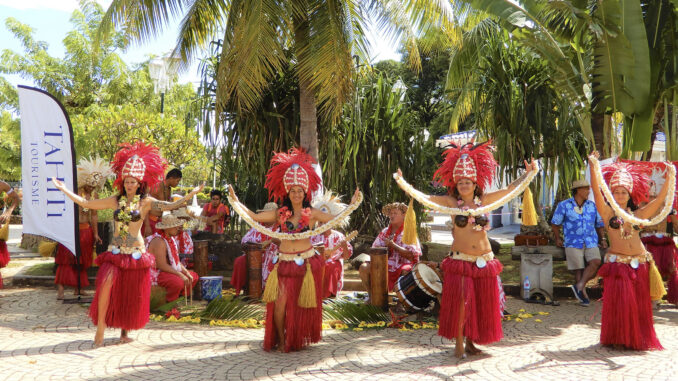
By Georgina Cruz
If someone would ask me to name my favorite earthly Eden, my answer would be Tahiti and its islands of Bora Bora and Moorea in French Polynesia. An archipelago of 118 islands in the South Seas, French Polynesia is a spot of incredible and impressive beauty, with blue lagoons, majestic mountains clad in green, cascades, fiery and dramatic sunsets and a French and Polynesian ambiance including a sense of “joie de vivre,” evident in the smiles and warm welcome that the islands’ residents give visitors. Post-Impressionist artist, Paul Gauguin, came to live in Tahiti for a time, and novelists James Michener and Herman Melville, among other luminaries also visited Tahiti and its islands, as well as many rich and famous celebrities like Julio Iglesias, Goldie Hawn, Pierce Brosnan, Jimmy Buffett and Bill Gates who have vacationed in French Polynesia.
“These islands make me feel special,” said Meghan Travis, a visitor from Palo Alto, California, while sipping a beverage on the beach of the InterContinental Tahiti Resort. “Just look around and you are in paradise.”
Tahiti is the biggest island in French Polynesia (it is 651 square miles) and it is made up of two round parts –like a number eight lying on its side— the biggest, western, round part is Tahití Nui, where the capital, Papeete is located, and the smaller part, Tahití Iti, is more rural. The Taravao Isthmus connects both parts. The island has awesome mountains including Mount Orohena (elevation: 7,334 feet) and Mount Aorai (6,738 feet) that are visible from Papeete’s center.
Tahiti is cosmopolitan and busier than the other islands of French Polynesia. It encompasses one fourth of the land of the islands and has some 180,000 residents or approximately two-thirds of the islands’ population. Another characteristic of Papeete is its French ambiance. It has a promenade by the sea that recalls the Riviera, with views of luxury yachts and it is fun to sit at one of the cafes and people watch. In its shops visitors can buy French perfumes, fashions and wines.
Centre Vaima on Boulevard Pomare is a four-level shopping center filled with boutiques and shops as well as a Pearl Museum –French Polynesian pearls are lovely and coveted by well-heeled visitors. Another shopping “must” is the Municipal Market (Le Marché) also in the heart of the city and with a great dose of Polynesian local color. Located a block from Boulevard Pomare, between rue du 22 Septembre and rue Francois Cardella, this huge market covers 75,350 square feet. Merchants come from all over the island and sometimes from other islands to sell their goods here. Everything is on sale: flowers, including fragrant tiare from the islands; pearls; wood carvings; traditional Polynesian clothing; shells; coffee; fruits and vegetables; meats and sweets, among other merchandise. We always buy several bottles of monoi oil (coconut oil with the tiare flower). This oil is what Polynesian women use on their lovely skin and hair.
Another point of interest in the center is the Cathedral of Notre Dame de Papeete. Consecrated in 1875 and restored in the 20th century, it is a Catholic cathedral in Gothic style in the Place Notre Dame, rue Jeanne d’Arc and rue General de Gaulle. It is a tranquil and lovely spot to rest during a tour of the city and has beautiful windows and a carving of the Virgin Mary and Baby Jesus in Polynesian style. Over the centuries it has survived a tsunami in 1906, a bombing of the city by the Germans in1914, a hurricane in 1983 and riots in 1987.
Cultural attractions include the Museum of Tahiti & Her Islands, in Punaauia, nine miles west of Papeete, with historic and cultural exhibits. Other points of interest regarding the islands’ culture include the Arahurahu Marae, a restored Polynesian temple that is maintained as a museum in Paea, 14 miles west of Papeete; and the tomb of King Pomare V (the last king of Tahití, who abdicated to the French in1880). It is located in Point Outuaiai in Arue.
In Tahití Iti, villages, beaches, cascades, marees (templos), archeological sites and caves with petroglyphs beckon to travelers. Among the points of interest are the Arahoho Blowhole, that looks like a natural fountain in the sea, and Point Venus, where British captain, James Cook, observed the transit of Venus for longitudinal studies in 1769 –it has a lighthouse from the 19th century.
Combining Tahiti with one or more of its nearby islands –perhaps the most famous ones of Bora Bora and Moorea, is ideal for a relaxing vacation. A few days enjoying their excellent resorts with facilities that include overwater bungalows and spas are simply lovely and memorable. Those islands also have restaurants frequented by the rich and famous, like Bloody Mary’s in Bora Bora and the superb establishments of the Four Seasons Bora Bora.
And now for 2023, travelers can say “oui” to French Polynesia more easily as the Tahiti & Her Islands Tourist Board has announced a variety of packages that include airfare via Air Tahiti Nui, lodging and excursions. Among the 10 packages being offered there is one that combines Tahiti and Bora Bora for $1,999 per person, double occupancy including airfare from Los Angeles or Seattle, lodging in five-star hotels and tours.
IF YOU GO – For information, visit www.TahitiTourisme.com.
A Tahiti Papeete tiare welcomes visitors to the islands. Tahiti is cosmopolitan and busier than the other islands of French Polynesia. It encompasses one fourth of the land of the islands and has some 180,000 residents or approximately two-thirds of the islands’ population.
